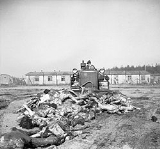
Bergen-Belsen concentration camp
Overview
Bergen-Belsen was a Nazi concentration camp in Lower Saxony
in northwestern Germany
, southwest of the town of Bergen
near Celle
. Originally established as the prisoner of war camp Stalag XI-C
, in 1943 it became a concentration camp on the orders of Heinrich Himmler
, where Jewish hostages were held with the intention of exchanging them for German prisoners of war held overseas. Later still the name was applied to the displaced persons camp
established nearby, but it is most commonly associated with the concentration camp it became as conditions deteriorated between 1943-1945.
Lower Saxony
Lower Saxony is a German state situated in north-western Germany and is second in area and fourth in population among the sixteen states of Germany...
in northwestern Germany
Germany
Germany , officially the Federal Republic of Germany , is a federal parliamentary republic in Europe. The country consists of 16 states while the capital and largest city is Berlin. Germany covers an area of 357,021 km2 and has a largely temperate seasonal climate...
, southwest of the town of Bergen
Bergen, Lower Saxony
Bergen is a town in the north of Celle district on the Lüneburg Heath, in Lower Saxony, Germany. Administratively it acts as a municipal borough divided into 12 subordinate parishes based on the town and its surrounding villages: Becklingen, Belsen, Bergen, Bleckmar, Diesten, Dohnsen, Eversen,...
near Celle
Celle
Celle is a town and capital of the district of Celle, in Lower Saxony, Germany. The town is situated on the banks of the River Aller, a tributary of the Weser and has a population of about 71,000...
. Originally established as the prisoner of war camp Stalag XI-C
Stalag XI-C
Stalg XI-C Bergen-Belsen, initially called Stalag 311, was a German Army prisoner-of-war camp located near the town of Bergen in Lower Saxony.-Timeline:...
, in 1943 it became a concentration camp on the orders of Heinrich Himmler
Heinrich Himmler
Heinrich Luitpold Himmler was Reichsführer of the SS, a military commander, and a leading member of the Nazi Party. As Chief of the German Police and the Minister of the Interior from 1943, Himmler oversaw all internal and external police and security forces, including the Gestapo...
, where Jewish hostages were held with the intention of exchanging them for German prisoners of war held overseas. Later still the name was applied to the displaced persons camp
Bergen-Belsen DP camp
Near the Bergen-Belsen concentration camp, British forces established a displaced persons camp for refugees after World War II. The site used abandoned German army Panzer barracks for housing facilities, and after November 1945, Jewish refugees were given their own section...
established nearby, but it is most commonly associated with the concentration camp it became as conditions deteriorated between 1943-1945.
Discussions

